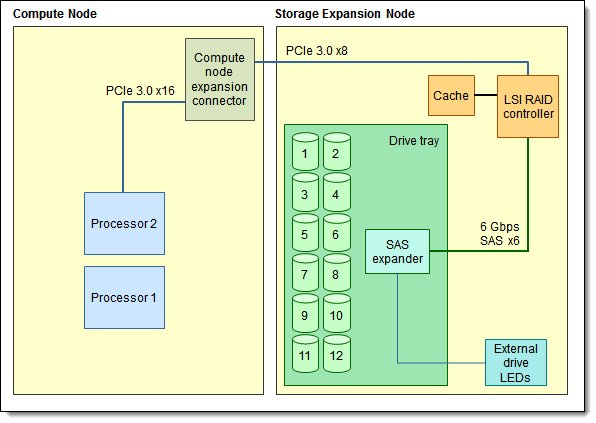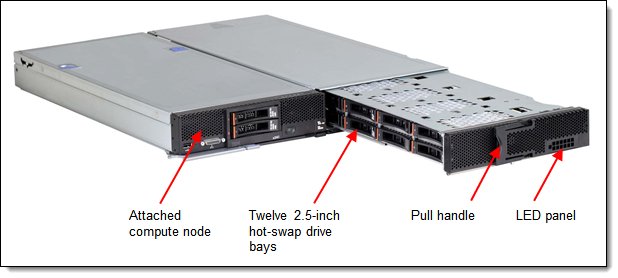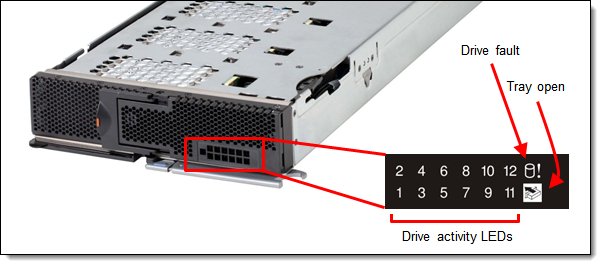Abstract
The Flex System™ Storage Expansion Node is a storage enclosure that attaches to a single half-wide compute node to provide that compute node with additional direct-attach local storage. The Storage Expansion Node provide flexible storage to match capacity, performance, and reliability needs.
Withdrawn: The Storage Expansion Node is now withdrawn from marketing as of April 28, 2017.
Introduction
The Flex System™ Storage Expansion Node is a storage enclosure that attaches to a single half-wide compute node to provide that compute node with additional direct-attach local storage. The Storage Expansion Node provide flexible storage to match capacity, performance, and reliability needs.
Ideal workloads include distributed database, transactional database, NAS infrastructure, video surveillance and streaming solutions. For example, when coupled with third-party NAS software, the combined compute node and storage expansion node make for an ideal infrastructure platform for a network-attached storage (NAS) server.
Figure 1 shows the Flex System Storage Expansion Node attached to an Flex System x240 Compute Node.

Figure 1. Flex System Storage Expansion Node (right) attached to an x240 Compute Node (left)
Did you know?
The Storage Expansion Node adds 12 drive bays to the attached compute node and all bays in the expansion node are hot-swap. The drive bays slide out on an internal rail system; provided that a suitable RAID level is employed, a failed drive can be removed while the system is still running. With storage capacity of up to 19 TB, the Storage Expansion Node is ideal for applications that can use large amounts of additional local storage.
Part number information
Table 1. Ordering part number and feature code
| Description | Part number | Feature code |
| Flex System Storage Expansion Node | 68Y8588 | A3JF |
The part number includes the following items:
- Flex System Storage Expansion Node
- Double-wide shelf
- Documentation flyer
- Warranty information and Safety flyer and Important Notices document
Supported servers
The Flex System Storage Expansion Node is supported when it is attached to the Flex System compute nodes listed in Table 2. Only one Expansion Node can be attached to each compute node.
Note: The Storage Expansion Node is not supported with any Power Systems compute nodes.
| Part number |
Description |
x220 (7906)
|
x222 (7916)
|
x240 (8737, E5-2600)
|
x240 (8737, E5-2600 v2)
|
x240 (7162)
|
x240 M5 (9532)
|
x240 M5 (9532, E5-2600 v4)
|
x440 (7917)
|
x440 (7167)
|
x880/x480/x280 X6 (7903)
|
x280/x480/x880 X6 (7196)
|
|---|---|---|---|---|---|---|---|---|---|---|---|---|
| 68Y8588 | Flex System Storage Expansion Node | Y* | N | Y* | Y* | Y* | Y* | Y* | N | N | N | N |
* The Storage Expansion Node requires that both processors be installed in the attached server.
Features
The System Expansion Node has the following features:
- Connects directly to supported compute nodes via a PCIe 3.0 interface to the compute node's interposer connector (also known as the ETE connector)
- Support for 12 hot-swap 2.5-inch drives, accessible via a sliding tray
- Support for 6 Gbps SAS and SATA drives, both HDDs and SSDs
- Based on an LSI SAS2208 6 Gbps RAID on Chip (ROC) controller
- Optional 512 MB or 1 GB cache with cache-to-flash super capacitor off-load
- Supports RAID 0, 1, 10 as standard. JBOD also supported. Optional RAID 5, 50 with cache upgrade. (Note: The original RAID 6, 60 upgrade option is withdrawn from marketing)
- Includes an expansion shelf to physically support the Storage Expansion Node and its compute node attached together
- Internal and external light path diagnostics
- Optional support for SSD performance acceleration with Features on Demand upgrade
- Support for up to 64 virtual drives, up to 128 drive groups, up to 16 virtual drives per one drive group, and up to 32 physical drives per one drive group
- Support for logical unit number (LUN) sizes up to 64 TB
- Configurable stripe size up to 1 MB
- Compliant with Disk Data Format (DDF) configuration on disk (COD)
- S.M.A.R.T. support
- Managed through the IMMv2 management processor on the compute node and with the MegaRAID Storage Manager management software
Architecture
Figure 2 shows the architecture of the Storage Expansion Node when connected to a compute node.

Figure 2. Architecture of the Storage Expansion Node
The Expansion Node connects to a standard-width compute node using the interposer cable, which plugs into the expansion connector on the compute node. This link forms a PCIe 3.0 x8 connection between Processor 2 on the compute node and the LSI RAID controller in the Expansion Node. The result is that the compute node sees the disks in the expansion node as locally attached. Management of the Storage Expansion Node is via the IMMv2 located on the compute node.
Note: The expansion connector in the x220 and x240 compute nodes is routed through processor 2. Therefore, processor 2 must be installed in the compute node.
Supported drives
The Storage Expansion Node is a PCIe 3.0 and a SAS 2.1 complaint enclosure supporting up to twelve 2.5-inch drives. The drives can be HDD or SSD, and both SAS or SATA. Drive modes supported are JBOD or RAID. Supported RAID modes are RAID-0, 1, 5, 10, and 50 (cache upgrade required for RAID 5, 50 support).
The drives are accessed by opening the handle on the front of the Storage Expansion Node and sliding out the drive tray. Opening the drive tray can be done while it is operational. Figure 3 shows the Storage Expansion Node connected to an x240 compute node and with the drive tray extended part way out. With the drive tray extended, all twelve hot-swap drives can be accessed on the left side of the tray.

Figure 3. Storage Expansion Node with drive tray part way extended
The following tables lists the hard disk drives (HDDs) and solid state drives (SSDs) supported within the Storage Expansion Node. Drive support is dependent on the compute node that is attached to the expansion node.
Both SSDs and HDDs can be installed inside the unit at the same time. Preferred practice when creating logical drives is to use similar disk types. For example, for a RAID 1 pair, choose identical drive types, SSD or HDD.
| Part number | Feature code | Description |
x220 (7906)
|
x240 (8737, E5-2600)
|
x240 (8737, E5-2600 v2)
|
x240 (7162)
|
x240 M5 (9532)
|
|---|---|---|---|---|---|---|---|
| 2.5-inch hot-swap HDDs - 6 Gb SAS 10K | |||||||
| 90Y8877 | A2XC | 300GB 10K 6Gbps SAS 2.5" SFF G2HS HDD | Y | Y | Y | Y | Y |
| 90Y8872 | A2XD | 600GB 10K 6Gbps SAS 2.5" SFF G2HS HDD | Y | Y | Y | Y | Y |
| 81Y9650 | A282 | 900GB 10K 6Gbps SAS 2.5" SFF HS HDD | Y | Y | Y | Y | Y |
| 00AD075 | A48S | 1.2TB 10K 6Gbps SAS 2.5" G2HS HDD | Y | Y | N | Y | N |
| 2.5-inch hot-swap HDDs - 6 Gb SAS 15K | |||||||
| 00AJ300 | A4VB | 600GB 15K 6Gbps SAS 2.5" G2HS HDD | Y | Y | Y | Y | Y |
| 2.5-inch hot-swap HDDs - 6 Gb NL SATA | |||||||
| 81Y9726 | A1NZ | 500GB 7.2K 6Gbps NL SATA 2.5" SFF HS HDD | Y | Y | Y | Y | Y |
| 81Y9730 | A1AV | 1TB 7.2K 6Gbps NL SATA 2.5" SFF HS HDD | Y | Y | Y | Y | Y |
| Part number | Feature code | Description |
x220 (7906)
|
x240 (8737, E5-2600)
|
x240 (8737, E5-2600 v2)
|
x240 (7162)
|
x240 M5 (9532)
|
|---|---|---|---|---|---|---|---|
| 2.5-inch hot-swap SSDs - 6 Gb SAS - Enterprise Performance (10+ DWPD) | |||||||
| 49Y6129 | A3EW | 200GB SAS 2.5" MLC HS Enterprise SSD | Y | N | N | Y | N |
| 49Y6134 | A3EY | 400GB SAS 2.5" MLC HS Enterprise SSD | Y | N | N | Y | N |
| 49Y6139 | A3F0 | 800GB SAS 2.5" MLC HS Enterprise SSD | Y | N | N | Y | N |
| 49Y6195 | A4GH | 1.6TB SAS 2.5" MLC HS Enterprise SSD | Y | Y | Y | Y | N |
| 2.5-inch hot-swap SSDs - 6 Gb SATA - Enterprise Mainstream (3-5 DWPD) | |||||||
| 00AJ355 | A56Z | 120GB SATA 2.5" MLC HS Enterprise Value SSD | Y | Y | Y | Y | Y |
| 00AJ360 | A570 | 240GB SATA 2.5" MLC HS Enterprise Value SSD | Y | Y | Y | Y | Y |
| 00AJ365 | A571 | 480GB SATA 2.5" MLC HS Enterprise Value SSD | Y | Y | Y | Y | Y |
| 00AJ370 | A572 | 800GB SATA 2.5" MLC HS Enterprise Value SSD | Y | Y | Y | Y | Y |
| 2.5-inch hot-swap SSDs - 6 Gb SATA - Enterprise Entry (<3 DWPD) | |||||||
| 00AJ000 | A4KM | S3500 120GB SATA 2.5" MLC HS Enterprise Value SSD | Y | Y | Y | Y | N |
| 00AJ005 | A4KN | S3500 240GB SATA 2.5" MLC HS Enterprise Value SSD | Y | Y | Y | Y | N |
| 00AJ010 | A4KP | S3500 480GB SATA 2.5" MLC HS Enterprise Value SSD | Y | Y | Y | Y | N |
| 00AJ015 | A4KQ | S3500 800GB SATA 2.5" MLC HS Enterprise Value SSD | Y | Y | Y | Y | N |
Feature upgrades
The Storage Expansion Node supports the upgrades listed in the following table.
Table 5. Supported adapter cards
| Part number |
Feature code |
Description | Maximum supported |
| Cache upgrades (also adds support for RAID 5 and RAID 50) | |||
| 81Y4559 | A1WY | ServeRAID M5100 Series 1GB Flash/RAID 5 Upgrade for System x® | 1* |
| 81Y4487 | A1J4 | ServeRAID M5100 Series 512MB Flash/RAID 5 Upgrade for System x | 1* |
| Features on Demand upgrades (license only) | |||
| 90Y4412 | A2Y2 | ServeRAID M5100 Series Performance Accelerator for Flex System | 1** |
* The cache upgrades are mutually exclusive.
** FoD upgrades require one of the cache upgrades also be ordered (81Y4559 or 81Y4487). FoD upgrades for ServeRAID are system-wide: If you have these features installed on the M5115 in the compute node they will automatically be activated on the LSI controller in the Storage Expansion Node.
ServeRAID M5100 Series 512MB and 1GB Flash Upgrade option part numbers include the following items:
- Cache module
- Flash power module
- Cable
The cache module is installed at the rear of the Storage Expansion Node and the power module is installed near the front of the expansion node. The provided cable is used to connect the cache module to the power module.
Figure 4 shows the flash-backed cache module, power module, and power cable.

Figure 4. Flash-backed cache module, power module, and power cable
The Performance Accelerator Upgrade for Flex System, part number 90Y4412 (implemented using the LSI MegaRAID FastPath software) provides high performance I/O acceleration for SSD-based virtual drives by using an extremely low latency I/O path to increase the maximum I/O per second (IOPS) capability of the controller. This feature boosts the performance of applications with a highly random data storage access pattern, such as transactional databases. Part number 90Y4412 is a Feature on Demand license. Requires one of the cache upgrades also be ordered (81Y4559 or 81Y4487).
FoD upgrades are system-wide: The FoD upgrades are the same ones as used with the ServeRAD M5115 available for use internally in the x220 and x240 compute nodes. If you have an M5115 installed in the attached compute node and have installed any of these upgrades, the upgrades will automatically be activated on the LSI controller in the Storage Expansion Node. You do not need to purchase the FoD upgrades separately for the expansion node.
LED indicators
The Storage Expansion Node has a number of LEDs on the lower right front for identification and status purposes, as shown in Figure 5.

Figure 5. LEDs on the front of the Storage Expansion Node
The following table identifies the meanings of the LEDs.
Table 6. External LED status table
| LED | Color | Meaning |
| Activity light (each drive bay) |
Green |
|
| Fault/Locate | Amber |
|
| Tray Open | Amber |
|
In addition to the lights described in the previous table, there are LEDs locally on each of the drive trays. These lights can be observed when the drive tray is extended and the unit is operational. A green LED indicates disk activity and an amber LED indicates a drive fault.
With the Storage Expansion Node removed from the Flex System chassis and its cover removed, there are additional LEDs visible. If there is a fault detected then the relevant LED will light:
- Flash/RAID adapter: RAID Cache card fault.
- Control panel: LED panel card not present
- Temperature: A temperature event has occurred
- Storage expansion: Fault on the storage expansion unit
- Light path: Verify that the light path diagnostic function, including the battery, is operating properly
Physical specifications
Dimensions and weight (approximate):
- Height: 56 mm (2.2 in.)
- Depth: 504 mm (19.8 in.)
- Width: 229 mm (9.2 in.)
- Maximum weight: 5.9 kg (13 lb)
Shipping dimensions and weight (approximate):
- Height: 240 mm (9.5 in.)
- Depth: 680 mm (26.8 in.)
- Width: 601 mm (23.7 in.)
- Weight: 9.5 kg (21 lb)
Operating environment
When the unit is powered on, it is supported in the following environment:
- Temperature: 5° C to 40° C (41° F to 104° F)
- Humidity, non-condensing: -12° C dew point (10° F) and 8% - 85% relative humidity
- Maximum dew point: 24° C (75° F)
- Maximum altitude: 3048 m (10,000 ft)
- Maximum rate of temperature change: 5° C/hr (41° F/hr)
Regulatory compliance
The unit conforms to the following standards:
- ASHRAE Class A3
- FCC - Verified to comply with Part 15 of the FCC Rules Class A
- Canada ICES-004, issue 3 Class A
- UL/IEC 60950-1
- CSA C22.2 No. 60950-1
- NOM-019
- Argentina IEC 60950-1
- Japan VCCI, Class A
- IEC 60950-1 (CB Certificate and CB Test Report)
- China CCC (GB4943); (GB9254, Class A); (GB17625.1)
- Taiwan BSMI CNS13438, Class A; CNS14336
- Australia/New Zealand AS/NZS CISPR 22, Class A
- Korea KN22, Class A, KN24
- Russia/GOST ME01, IEC 60950-1, GOST R 51318.22, GOST R
- 51318.249, GOST R 51317.3.2, GOST R 51317.3.3
- IEC 60950-1 (CB Certificate and CB Test Report)
- CE Mark (EN55022 Class A, EN60950-1, EN55024, EN61000-3-2,
- EN61000-3-3)
- CISPR 22, Class A
- TUV-GS (EN60950-1/IEC 60950-1, EK1-ITB2000)
Related product families
Product families related to this document are the following:
Trademarks
Lenovo and the Lenovo logo are trademarks or registered trademarks of Lenovo in the United States, other countries, or both. A current list of Lenovo trademarks is available on the Web at https://www.lenovo.com/us/en/legal/copytrade/.
The following terms are trademarks of Lenovo in the United States, other countries, or both:
Lenovo®
ServerProven®
System x®
Other company, product, or service names may be trademarks or service marks of others.
